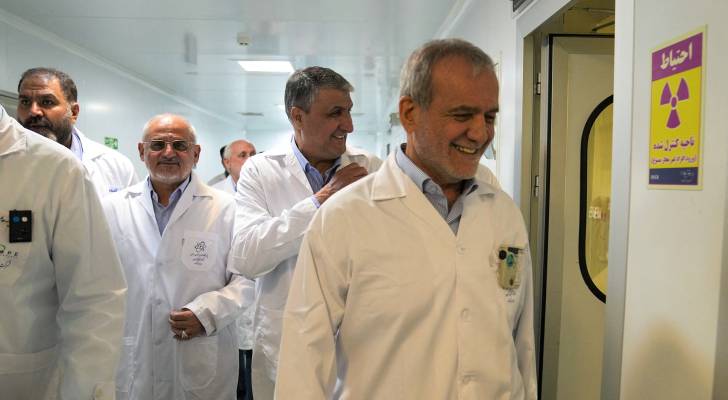Iranian President Masoud Pezeshkian during a visit to the Atomic Energy Organization of Iran in Tehran.
Iran says will rebuild destroyed nuclear facilities “stronger than before”
- Iran President Masoud Pezeshkian pledged that the US strikes in June would not halt Tehran’s nuclear progress.
- The vow follows the devastating “Operation Midnight Hammer” strikes that targeted key facilities, including Fordow and Natanz.
- Tehran maintained that the program is purely civilian
Iranian President Masoud Pezeshkian declared on Sunday that the United States attacks on the country’s nuclear facilities in June would fail to halt Tehran’s progress, vowing to rebuild the destroyed installations “stronger than before”.
Speaking during a high-profile visit to the Atomic Energy Organization of Iran (AEOI), President Pezeshkian sought to downplay the impact of physical damage, emphasizing the durability of Iranian scientific knowledge.
"Destroying buildings and factories will not create a problem for us,” he stated. “Science is in the minds of our scientists, and there will be no problem with destroying buildings and factories; we will build again and with more vigour”.
Pezeshkian also used the platform to reiterate Iran’s consistent stance that its nuclear activities are solely for civilian purposes, insisting the programs are intended "for solving people's problems, for treating diseases and for the health of society".
Assessing the Damage from Operation Midnight Hammer
The US strikes, known as Operation Midnight Hammer, targeted Iran's most critical nuclear infrastructure, including the deeply buried Fordow Uranium Enrichment Plant, the Natanz Nuclear Facility, and the Isfahan Nuclear Technology Center.
The offensive utilized specialized GBU-57A/B Massive Ordnance Penetrator (“bunker buster” bombs) and Tomahawk missiles in a bid to neutralize Iran’s hardened underground facilities.
Initial assessments by US officials claimed the key enrichment facilities were "completely and totally obliterated".
However, International Atomic Energy Agency (IAEA) Director General Rafael Grossi later confirmed that while the sites suffered "severe damage," the destruction was not "total damage".
Specifically regarding the Fordow site, Grossi confirmed in September 2025 that "almost all sensitive equipment" had been destroyed.
Satellite imagery has since indicated continued construction at a major underground facility near Natanz and potential activity near Isfahan, compounding concerns over the shift to more clandestine sites.
Geopolitical Fallout and Verification Crisis
The military escalation has fractured international consensus and severely hampered diplomatic efforts, which had been underway in Oman until shortly before the strikes.
The international reaction to the military action was largely condemnatory. UN Secretary-General António Guterres told the Security Council that the bombing of nuclear sites marked a “perilous turn,” warning the region “cannot endure yet another cycle of destruction”. Russia and China strongly condemned the U.S. action, characterizing it as "irresponsible" and a "gross violation of international laws".
Adding to the complexity, in November 2025, IAEA Director General Rafael Grossi publicly admitted that inspections carried out by the Agency had found “no evidence of a nuclear weapons program” in Iran.
This admission, made months after the US justified its strike on the grounds of an imminent proliferation risk, was quickly leveraged by Tehran, which argued that previous "catastrophic statements" by Grossi had "paved the way for American and Israeli aggression".
In the aftermath of the strikes, Iran suspended full cooperation with the UN nuclear watchdog, restricting access to the damaged sites under a new post-war law.




